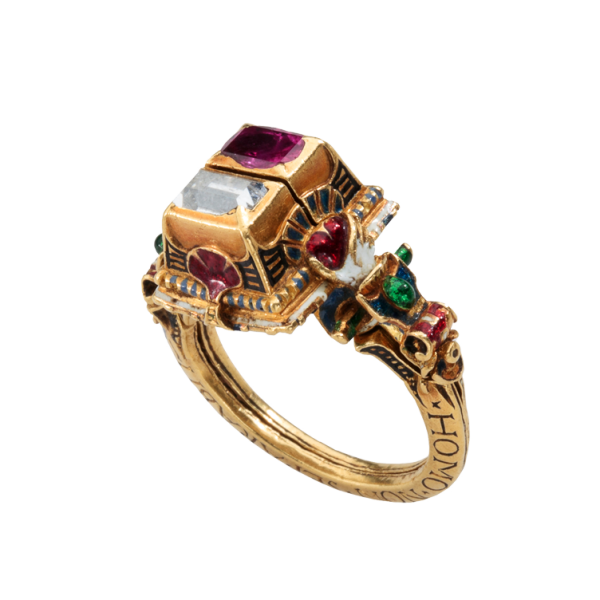Considerable evidence exists concerning the making and wearing of rings in the Renaissance. Their appearance in painted portraits confirms that they continued to be worn on multiple fingers, suspended from chains and ribbons, sewn onto sleeves or hats, and so forth. When not worn they were sometimes stored on parchment rolls or in neatly compartmentalized boxes, known from documents and paintings. In the Renaissance, the medieval practice of using uncut stones was abandoned in favor of faceting; table-cut facets were among the earliest and most popular, but other cuts rapidly followed. Making rings that would show off best the qualities of the stone became a skill that exercised the virtuosity of cutters, chasers, engravers, enamellers, and goldsmiths sometimes in collaboration. The highly sculpturesque quality of most Renaissance and Baroque rings can be compared with the striving for greater veracity that characterizes the monumental arts of this period.
By far the most common type of ring from the Renaissance was the boxed bezel set with faceted stones in highly ornate geometric bezels with intricate articulated shoulders, sometimes with protruding volutes, the whole richly enameled. Surviving drawings for rings by sixteenth-century goldsmith-designers Etienne Delaune, Pierre Woeiriot, and René Boyvin record variations on this type. Often reviving classical subjects and motifs, numerous cameos and intaglios also date from this era, produced under illustrious, often princely, patronage. By the sixteenth century the careers of famous gem-cutters can be reconstructed; they include Valerio Belli, Alessandro Cesati, Alessandro Masnago, and Francesco Torino. However, few Renaissance cameos and intaglios appear in their original mounts, because they were often made not as rings but rather as virtuoso carvings, kept in drawers in cabinets and taken out and admired by Renaissance princes.
During Elizabethan and Tudor times in England, commonplace books (the earliest dated 1596) were used by goldsmiths and their customers to provide appropriate inscriptions for rings. References to posy rings (from “poésie” or poetry) abound in literature of the period; for example, in Shakespeare's Hamlet (III, ii, 162): “Is this a prologue, or the posy of a ring.” The discovery of the New World also wrought changes in the evolution of rings, as it did for painting, because new stones became available. The newly prized diamond, expensive then as now, was often imitated by the similarly favored rock crystal. Extensive surviving pictorial evidence is useful because it contributes to a more precise dating and localization of rings from this era.
